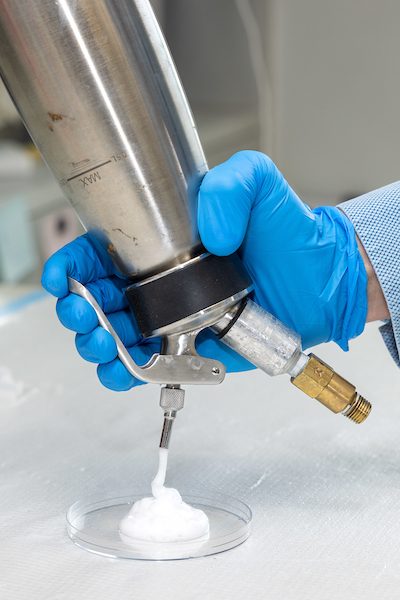
A new technique that heals diabetic wounds and pressure ulcers using carbon monoxide was inspired by culinary techniques, a new study finds.
Researchers led by University of Iowa assistant professor of radiation oncology and biomedical engineering Dr. James Byrne developed a carbon-monoxide-infused foam that can be applied topically to wounds and improves healing.
“Certain gases, like carbon monoxide, are known to have therapeutic properties if they are delivered in the right concentration at the right place. Our novel gas-entrapping materials, which can be formulated as foams or gels or even solids, allow us to deliver gases in a safe, prolonged fashion directly to the site where the therapy is needed,” Dr. Byrne said.
The results of the study were published March 12 in Device, a Cell Press journal.
Gas-entrapping materials could one day provide human therapies for diabetes
Diabetes affects almost 39 million Americans and causes numerous health complications. A negative side effect of diabetes is impaired wound healing, which results from chronic inflammation, a key feature of diabetes, and high blood sugar levels, which can fuel bacterial infections. Skin wounds and ulcers that do not heal well can be a major issue that sometimes leads to serious infections, amputation, or even death.
According to recent studies, topical gas therapies have the potential to improve wound healing. Carbon monoxide, generally thought of as a toxic gas, can deliver unique immune modulating effects that may be beneficial if localized in the right concentration.
Dr. Byrne and his colleagues developed a novel foam made from hyaluronic acid—a substance used in many skincare products—infused with carbon monoxide. The foam is safe and when applied to wounds, allows for prolonged delivery of the gas directly at the wound site for therapy.
The foam also contains silver nanoparticles, which have antimicrobial properties and have been shown to promote wound healing.
“Topical application of the CO-foam maximized the local delivery of carbon monoxide while maintaining safe levels of systemic carbon monoxide, and the two types of diabetic wounds healed better and faster than untreated wounds or wounds treated with inert nitrogen-foam,” Dr. Byrne said. “We still need to test this approach in models that more closely resemble human diabetic wounds, but eventually we hope to develop these gas-entrapping materials into human therapies.”
Ultimately, Dr. Byrne and his colleagues at Harvard Medical School and Massachusetts Institute of Technology (MIT) hope to develop a new company around the technology. In addition to wound-healing, the researchers are also exploring the use of gas-entrapping materials (GEMs) in various cancer therapies.
This story was based on a blog post by Jennifer Brown. Read the full story here.